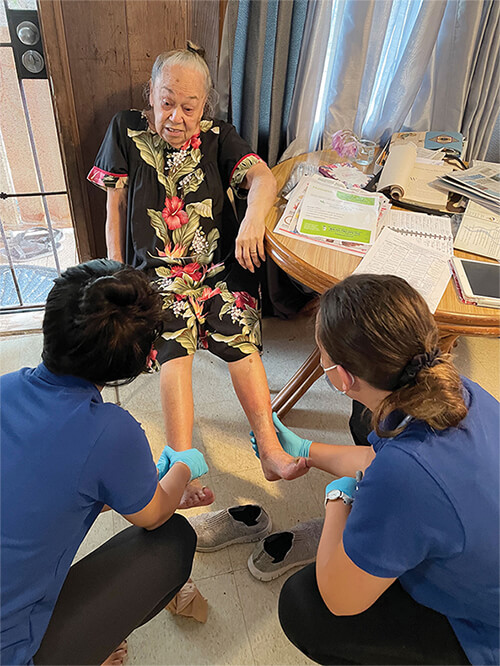Growing the Pipeline
Meet some of the people devoted to improving the Native Hawaiian community’s health and mentoring the next generation of Native Hawaiian medical experts.

Growing up, Marcus Iwane spent a lot of time with his grandfather in his garden in Nanakuli. “I remember him speaking to his plants in the Hawaiian language,” recalls Iwane. “It wasn’t until long after he passed that I started to connect to my roots, to being a Native Hawaiian, and what that means to look toward cultural health as a whole.”
Today, he is Marcus Iwane, M.D., an internist with Kaiser Permanente Hawaii. With Kaiser Permanente, he works out of the West Oahu Medical Office at Kapolei and he’s also an assistant clinical professor in medicine at his alma mater, the John A. Burns School of Medicine.
“I chose to become an internist and primary care physician because I enjoy getting to know my patients and seeing them across a continuum of time,” Iwane says. Combining Western knowledge with the fundamental teachings and wisdom of the Hawaiian culture and its kupuna is, he says, “an art form, and something that helps me make better connections to my patients.”
Iwane notes that social and environmental determinants play a large role in Native Hawaiian health. “Native Hawaiians have a high prevalence of chronic health diseases, such as diabetes, heart disease and hypertension, and cancer. We now have the highest infant and maternal mortality in the nation across all ethnicities. What can we do to shift this? Because when Captain Cook first arrived on our shores in 1778, he described in his journals a thriving, healthy, robust community, Hawaiians who were strong and nimble.”
As a professor of medicine at John A. Burns School of Medicine, he now shares his experiences, culture, and insights with a new generation of doctors. “I also help to teach some of our students at the Kaiser Permanente School of Medicine in Pasadena, where they also have a focus on social and cultural determinants and on health equity. “It’s important to educate people, not just within Hawaii, but also across states that have a large and growing population of Native Hawaiians, because these future doctors are going to care for them and see them in their clinics.”
Iwane is president of the board of ‘Ahahui o nā Kauka, the Association of Native Hawaiian Physicians. The nonprofit organization champions better health care for Native Hawaiians overall and seeks ways to increase the number of indigenous doctors in Hawaii – and beyond. “Approximately 20% of Hawaii’s population is Native Hawaiian, but less than 5% of the state’s practicing physicians are Native Hawaiian, so we have a far way to go to parity,” he notes. To meet that goal, he says mentoring young people is a priority, as is tailoring health care approaches to the unique needs of a community. “We are building the pipeline of not just Native Hawaiians, but any folks who are vested in improving the health of our communities.”
Coming Full Circle
“I have known Dr. Iwane since he was a medical resident. Residents from JABSOM have supported our lomilomi group taking vitals for residents, such as blood pressure checks for over a decade,” says Adrienne Dillard, PhD.
Dillard, who has a master’s in social work and is a licensed clinical social worker, is the CEO of Kula No Nā Po‘e Hawai‘i. Known as KULA, it’s a nonprofit that promotes cultural, educational, environmental, and health equities for the residents of the Papakolea, Kewalo, and Kalawahine Hawaiian Homesteads, which together make up the Papakolea region on Oahu.

“KULA has been training community health workers in certificate and apprenticeship programs and bringing in nursing, social work, public health students, and medical residents for service learning opportunities from the University of Hawai‘i at Mānoa, Hawai‘i Pacific University, and Chaminade University to work within the community,” says Dillard. Students, working with a multidisciplinary team, might do home visits with a kupuna, for example.

Photo courtesy Kula No Nā Po‘e
KULA and the student medical professionals also play a role in research, working with the Dept. of Native Hawaiian Health at JABSOM for studies on chronic diseases that disproportionately affect Native Hawaiians.
“We are training community health workers,” says Dillard. “Kaiser Permanente has been instrumental in supporting that. At KULA we have on staff Native Hawaiians who were born and raised in the community and now work with us, and we have other members who are not Native Hawaiian but are passionate about serving in the community health arena. Community health is vast. It’s education, it’s clinical, but it’s also all the aspects of supporting your community.”
Kaiser Permanente Hawai‘i has supported these health initiatives, she says. “Most of our grants have been around Kaiser Permanente saying, ‘What do you need?’ We partnered with them for Covid vaccination clinics; we partner with them for the annual health fair. We train, mentor, and support this generation that is coming up.”
Now, KULA is looking for ways to develop its own health-training curriculum that is appropriate for Native Hawaiians in Hawai‘i. And it’s sharing insights on community health that the organization has gleaned over the years.
“I have been working in Papakōlea for 30 years,” says Dillard. “A lot of the staff that I am helping to train, they were born and raised in Papakōlea. We are raising them up to take it over and to do the work. It’s how we raise that next generation of Native Hawaiian health leaders.”